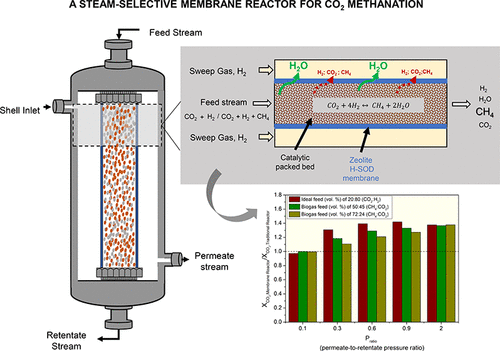当前位置:
X-MOL 学术
›
Ind. Eng. Chem. Res.
›
论文详情
Our official English website, www.x-mol.net, welcomes your
feedback! (Note: you will need to create a separate account there.)
Modeling and Simulation of a Steam-Selective Membrane Reactor for Enhanced CO2 Methanation
Industrial & Engineering Chemistry Research ( IF 3.8 ) Pub Date : 2020-08-18 , DOI: 10.1021/acs.iecr.0c02860 A. Catarina Faria 1 , C. V. Miguel 1 , A. E. Rodrigues 2 , L. M. Madeira 1
Industrial & Engineering Chemistry Research ( IF 3.8 ) Pub Date : 2020-08-18 , DOI: 10.1021/acs.iecr.0c02860 A. Catarina Faria 1 , C. V. Miguel 1 , A. E. Rodrigues 2 , L. M. Madeira 1
Affiliation

|
A modeling and simulation study of a hydroxy sodalite (H-SOD) membrane reactor for in situ steam removal during CO2 methanation reaction is presented. A nonisothermal, steady-state, pseudohomogeneous 1D mathematical model with axial dispersion was proposed to describe and compare the performance obtained with traditional fixed-bed and membrane reactors. The model was validated against experimental data taken from the literature, first concerning CO2 conversion in a fixed-bed reactor and then regarding mixture separation factors through the membrane. The reactor’s performance was assessed considering the CO2 conversion and CH4 outlet purity under different operating conditions. The membrane selectivity toward H2 is more significant than that for the other species (i.e., CH4 and CO2). Hence, if hydrogen is used as sweep gas it can be co-delivered from the permeate side, which was found to significantly enhance the membrane reactor performance. The permeate-to-retentate pressure ratio (Pratio) increases the CO2 conversion but only up to an optimum value (Pratio*), which depends on the reaction conditions and feed composition. This holds true particularly when processing raw biogas: increasing the Pratio leads to a trade-off situation, where CO2 conversion increases but CH4 purity decreases. High water selectivity of the membrane enables a significant improvement compared to the traditional reactor performance, particularly at high temperature, pressure, and contact time, even if some reactants are lost to the permeate. Notably, the membrane reactor excels over the traditional fixed-bed reactor even at milder temperatures and pressures, which is particularly relevant for improving the overall energy efficiency of power-to-methane processes.
中文翻译:

蒸汽选择性膜反应器用于增强CO 2甲烷化的建模与仿真
提出了一种在CO 2甲烷化反应过程中就地去除水蒸气的羟基方钠石(H-SOD)膜反应器的建模和模拟研究。提出了一种具有轴向色散的非等温稳态伪一维一维数学模型,以描述和比较传统固定床和膜式反应器的性能。根据从文献中获得的实验数据对模型进行了验证,首先涉及固定床反应器中的CO 2转化,然后涉及通过膜的混合物分离因子。考虑CO 2转化率和CH 4评估反应器性能不同操作条件下的出口纯度。膜对H 2的选择性比其他物种(即CH 4和CO 2)的膜选择性更高。因此,如果将氢气用作吹扫气体,则它可以从渗透侧共同输送,这被发现可以显着提高膜反应器的性能。渗透物与保留物的压力比(P ratio)增加了CO 2转化率,但仅达到最佳值(P ratio *),这取决于反应条件和进料组成。在处理原始沼气时尤其如此:提高磷比导致权衡情况,其中CO 2转化率增加,但CH 4纯度降低。与传统的反应器性能相比,膜的高水选择性可实现显着改善,特别是在高温,高压和接触时间下,即使某些反应物损失到渗透液中也是如此。值得注意的是,即使在较温和的温度和压力下,膜反应器也优于传统的固定床反应器,这对于提高动力制甲烷工艺的整体能效尤为重要。
更新日期:2020-09-16
中文翻译:

蒸汽选择性膜反应器用于增强CO 2甲烷化的建模与仿真
提出了一种在CO 2甲烷化反应过程中就地去除水蒸气的羟基方钠石(H-SOD)膜反应器的建模和模拟研究。提出了一种具有轴向色散的非等温稳态伪一维一维数学模型,以描述和比较传统固定床和膜式反应器的性能。根据从文献中获得的实验数据对模型进行了验证,首先涉及固定床反应器中的CO 2转化,然后涉及通过膜的混合物分离因子。考虑CO 2转化率和CH 4评估反应器性能不同操作条件下的出口纯度。膜对H 2的选择性比其他物种(即CH 4和CO 2)的膜选择性更高。因此,如果将氢气用作吹扫气体,则它可以从渗透侧共同输送,这被发现可以显着提高膜反应器的性能。渗透物与保留物的压力比(P ratio)增加了CO 2转化率,但仅达到最佳值(P ratio *),这取决于反应条件和进料组成。在处理原始沼气时尤其如此:提高磷比导致权衡情况,其中CO 2转化率增加,但CH 4纯度降低。与传统的反应器性能相比,膜的高水选择性可实现显着改善,特别是在高温,高压和接触时间下,即使某些反应物损失到渗透液中也是如此。值得注意的是,即使在较温和的温度和压力下,膜反应器也优于传统的固定床反应器,这对于提高动力制甲烷工艺的整体能效尤为重要。











































 京公网安备 11010802027423号
京公网安备 11010802027423号